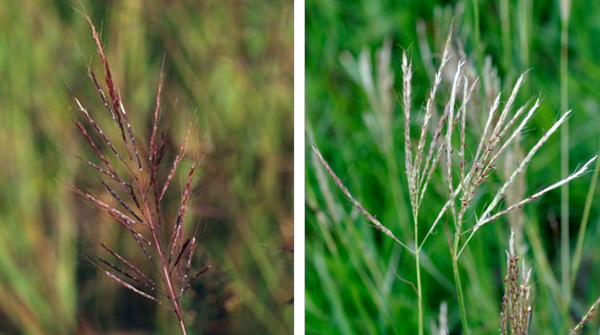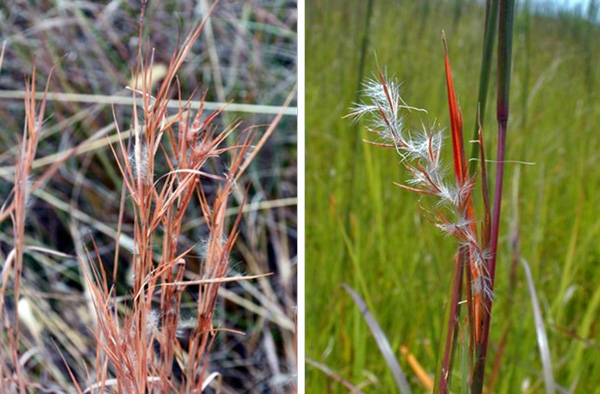Old World Bluestem (OWB) is a name collectively used to refer to Caucasian bluestem [Bothriochloa bladhii (Retz.) S.T. Blake] and various cultivars of yellow bluestem [Bothriochloa ischaemum (L.) Keng] including Turkestan bluestem and King Ranch bluestem. These plants are aggressive and prolific seed producers. They are adapted to high calcareous and high pH soils, and do well on any well-drained soil.
Today, OWBs can be seen along roadsides and are increasing in our native grasslands. The invasive nature and lower palatability of OWBs allow them to increase once established. Left uncontrolled, OWBs have the potential to dominate our grasslands. These species were introduced into the U.S. for conservation purposes and as a forage crop for haying and grazing. In recent years, OWBs have been used commonly in the southern Great Plains (Oklahoma and Texas) in grassland plantings and on Conservation Reserve Program (CRP) acres, but are not recommended for use in Kansas.
Seedings of Old World Bluestems in Kansas probably started during the 1930s and continued to some extent into the 1960s. Although a number of species are called bluestems, OWBs are not closely related to the native grasses, little bluestem and big bluestem.

Figure 1. Caucasian bluestem (left) and Yellow bluestem (right) inflorescence. Images by Mike Haddock, KSwildflower.org
Broomsedge bluestem (Andropogon virginicus, also referred to as broomsage, broomsedge, and yellow bluestem) is a native, warm-season, perennial bunchgrass that grows up to 4 feet tall. The stem bases are flat and may or may not have hair. The orange-brown or straw-colored foliage helps distinguish broomsedge. The seed heads are partially enclosed by large, inflated sheaths.
Broomsedge grows well in old fields that are eroded and low in fertility. It is seldom eaten by livestock. The grass starts growth when temperatures remain consistently over 60°F, produces many seeds carried by the wind, and is a poor competitor. This plant is not well grazed due to poor forage quality and low palatability. Despite being a poor competitor, it can be a dominant species when the perfect conditions arise: greater grazing pressure, low pH (<5.5), low phosphorus, and eroded soils.

Figure 2. Broomsedge bluestem (left) and little bluestem (right) inflorescence. Images by Mike Haddock, KSwildflower.org.
Table 1. Comparison of Old World bluestems, broomsedge bluestem, and little bluestem.
|
|
Old World Bluestems |
|
|
|
|
|
Yellow bluestem |
Caucasian bluestem |
Brooomsedge bluestem |
Little bluestem |
|
Scientific name |
Bothriochloa |
Bothriochloa bladhii |
Andropogon virginicus |
Schizachyrium scoparium |
|
Origin |
Southern Asia |
Southern Asia, Africa, Australia |
Native |
Native |
|
Life cycle |
Warm-season perennial |
Warm-season perennial |
Warm-season perennial |
Warm-season perennial |
|
Height |
1.5 to 3 feet |
1 to 3 feet |
Up to 4 feet |
Up to 5 feet |
|
Stem |
Flattened near base, grooved on one side |
Flattened near base, grooved on one side, nodes purple-tinged |
Flattened near base, branched near top, filled with white pith |
Flattened near base, many branches |
|
Leaf sheath |
Usually hairless |
Usually hairless |
Overlapping, margins may have hairs |
Open, usually hairless |
|
Leaf shape |
Folded, up to 9 inches long, up to 1/5 inch wide |
Folded, up to 15 inches long, up to ¼ inch wide |
Folded, 6 to 16 inches, up to 1/3 inch wide |
Folded, up to 12 inches long, up to ¼ inch wide |
|
Leaf color |
Yellow-green |
Yellow-green |
green |
gray-green/blue-green |
|
Leaf hairs |
Sparse hairs at base |
Sparse hairs at base |
Coarse hairs at base |
Long hairs near base |
|
Ligule |
Membrane fringed with hairs |
Membrane fringed with hairs |
Membrane fringed with hairs, up to 1/32 inch |
Membrane fringed with hairs, up to 1/10 inch |
|
Inflorescence |
1 to 3 inches long, 2 to 8 branches similar in length and originating near stem, yellow, hairy |
2.5 to 6 inches long, 4 to 12 branches shorter near the top, reddish-purple, hairy |
¾ to 1.5 inches long, 2 to 4 branches enclosed in spathe (leaf-like structures), feathery hairs, evenly distributed along stem |
1 to 3 inches long, and the end of each branch, not enclosed, feathery hairs |
|
Rhizomes |
Short and scaly |
Short and scaly |
Short, smooth |
Few, short, scaly |
|
Fall color |
Yellow/tan |
Yellow/tan |
Orange/copper |
Red/maroon |
Management options
Due to their perennial nature, multiple years of management will likely be needed to manage either OWB or broomsedge bluestem. Additionally, neither plant often gets grazed due to limited palatability and nutritional values compared to other native bluestems. Either species can get out of hand quickly as they can take over when the preferred forages receive greater use and are less able to compete.
Old World Bluestems
Both glyphosate and imazapyr (Arsenal, others) can reduce OWB. Current recommendations include mowing or burning followed by a broadcast application of glyphosate (3 lb ae/A) or imazapyr (0.5 lb ae/A). Ideally, herbicides will be applied before an infestation is widespread, which would allow spot treatment with a 2.5% (5 pints/25 gal) glyphosate solution or 1% (2 pts/25 gal) imazapyr. Also, growing season prescribed burns (late July and August) with abundant fuel and slow-moving fires have been able to significantly reduce OWB in native stands.
Re-establishing desirable vegetation may be a challenge with either glyphosate or imazapyr. Native vegetation, especially many native tallgrasses, seems to be more tolerant of imazapyr, which may allow for the survival of many desirable plants if treating invading OWB stands.
Broomsedge
Since this plant thrives on low pH and low fertility soils, soil testing is the first step in managing a broomsedge-infested field. Improved soil pH and fertility, especially phosphorus levels, will shift the competitive edge toward the desirable forages. This is not an instant fix and when budgets are limited, the priority should be adjusting pH with lime.
If broomsedge is shading desirable species lower in the canopy, mowing may be necessary to bring in more light. However, neither mowing nor prescribed burning will reduce broomsedge populations. The application of glyphosate during active growth, either as a spot spray or rope wick, can be an effective herbicide option.
Controlling broomsedge in native range sites is more difficult than in cool-season forages. Fire and grazing management are used to reduce or slow the spread in range sites. Native grasses do not respond efficiently to fertilizer like the introduced grasses. Therefore, the use of an intensive early stocking program to graze broomsedge, followed by resting the stand through the remainder of summer, is beneficial. Rest allows our desirable native grasses an opportunity to restore lost energy and produce a healthier, more competitive stand. Native hay meadows should only be baled once per year to increase competition with broomsedge.
For more information on identifying bluestem species in Kansas, see Rangeland and Pasture Grasses of Kansas, K-State publication C567.
For more information on controlling perennial grasses, see 2025 Chemical Weed Control for Field Crops, Pastures, Rangeland, and Noncropland, K-State publication SRP-1190.
The use of trade names is for clarity to readers and does not imply endorsement of a particular product, nor does exclusion imply non-approval. Always consult the herbicide label for the most current use requirements.
Sarah Lancaster, Extension Weed Management Specialist
slancaster@ksu.edu
Keith Harmoney, Range Scientist - Hays
kharmone@ksu.edu
Tina Sullivan, Northeast Area Agronomist
tsullivan@ksu.edu
Tags: pastures grazing rangeland Old World Bluestem broomsedge